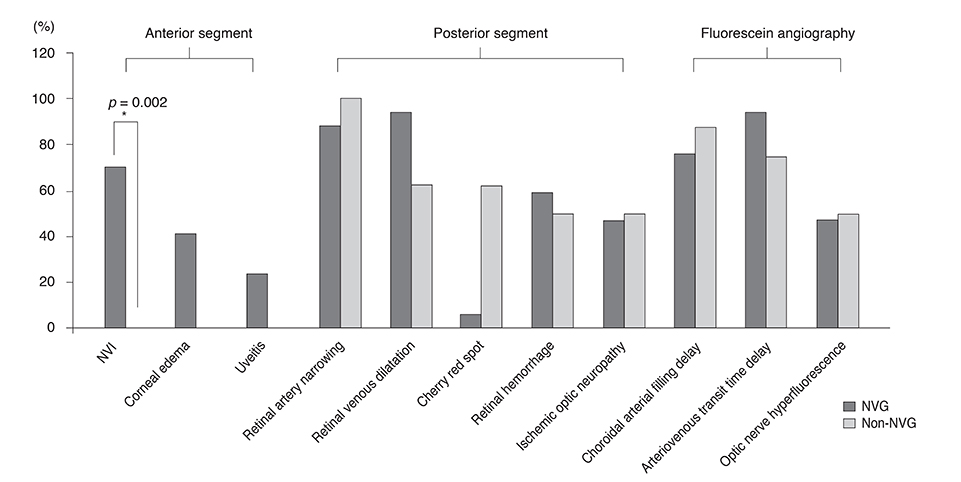Korean J Ophthalmol.
2017 Aug;31(4):343-350. 10.3341/kjo.2016.0067.
Clinical Features of Ocular Ischemic Syndrome and Risk Factors for Neovascular Glaucoma
- Affiliations
-
- 1Department of Ophthalmology and Research Institute of Medical Sciences, Chonnam National University Hospital, Chonnam National University Medical School, Gwangju, Korea. exo70@naver.com
- KMID: 2385584
- DOI: http://doi.org/10.3341/kjo.2016.0067
Abstract
- PURPOSE
We aimed to examine the clinical features and prognosis of ocular ischemic syndrome and to investigate the risk factors for the development of neovascular glaucoma (NVG).
METHODS
The medical records from 25 patients (25 eyes) who were diagnosed with ocular ischemic syndrome were retrospectively analyzed. We recorded the length of time between symptom onset and diagnosis, visual acuity, intraocular pressure, clinical findings of the anterior and posterior segments of the eye, fluorescein angiography, systemic diseases, smoking history, and the extent of any ipsilateral carotid artery stenosis. The risk factors for NVG in patients with ocular ischemic syndrome were investigated.
RESULTS
The mean age was 67.9 ± 12.5 years, and 21 men and 4 women were included in this study. At initial examination, the mean logarithm of the minimum angle of resolution (logMAR) was 2.02 ± 1.26, and the mean intraocular pressure was 21.0 ± 10.3 mmHg. Among 25 eyes of the 25 patients, NVG occurred in 17 eyes after a mean period of 12.6 ± 14.0 months. The length of time between symptom onset and diagnosis (p = 0.025) and the extent of ipsilateral carotid artery stenosis (p = 0.032) were identified as significant risk factors for NVG. At the final follow-up, the mean logMAR visual acuity was 3.13 ± 1.24, showing a poor prognosis regardless of whether NVG occurred.
CONCLUSIONS
Overall, the prognosis for ocular ischemic syndrome is very poor. The risk of NVG increases with the length of time between symptom onset and diagnosis, as well as with the severity of ipsilateral carotid artery stenosis.
MeSH Terms
Figure
Reference
-
1. Terelak-Borys B, Skonieczna K, Grabska-Liberek I. Ocular ischemic syndrome: a systematic review. Med Sci Monit. 2012; 18:RA138–RA144.2. Mizener JB, Podhajsky P, Hayreh SS. Ocular ischemic syndrome. Ophthalmology. 1997; 104:859–864.3. Magargal LE, Sanborn GE, Zimmerman A. Venous stasis retinopathy associated with embolic obstruction of the central retinal artery. J Clin Neuroophthalmol. 1982; 2:113–118.4. Lyons-Wait VA, Anderson SF, Townsend JC, De Land P. Ocular and systemic findings and their correlation with hemodynamically significant carotid artery stenosis: a retrospective study. Optom Vis Sci. 2002; 79:353–362.5. Kearns TP. Differential diagnosis of central retinal vein obstruction. Ophthalmology. 1983; 90:475–480.6. Lazzaro EC. Retinal-vein occlusions: carotid artery evaluation indicated. Ann Ophthalmol. 1986; 18:116–117.7. North American Symptomatic Carotid Endarterectomy Trial Collaborators. Beneficial effect of carotid endarterectomy in symptomatic patients with high-grade carotid stenosis. N Engl J Med. 1991; 325:445–453.8. Mills RP. Anterior segment ischemia secondary to carotid occlusive disease. J Clin Neuroophthalmol. 1989; 9:200–204.9. Sivalingam A, Brown GC, Magargal LE, Menduke H. The ocular ischemic syndrome. II: Mortality and systemic morbidity. Int Ophthalmol. 1989; 13:187–191.10. Brown GC, Magargal LE. The ocular ischemic syndrome. Clinical, fluorescein angiographic and carotid angiographic features. Int Ophthalmol. 1988; 11:239–251.11. Sivalingam A, Brown GC, Magargal LE. The ocular ischemic syndrome. III: Visual prognosis and the effect of treatment. Int Ophthalmol. 1991; 15:15–20.12. Mendrinos E, Machinis TG, Pournaras CJ. Ocular ischemic syndrome. Surv Ophthalmol. 2010; 55:2–34.13. Sivak-Callcott JA, O'Day DM, Gass JD, Tsai JC. Evidence-based recommendations for the diagnosis and treatment of neovascular glaucoma. Ophthalmology. 2001; 108:1767–1776.14. Shazly TA, Latina MA. Neovascular glaucoma: etiology, diagnosis and prognosis. Semin Ophthalmol. 2009; 24:113–121.15. Ino-ue M, Azumi A, Kajiura-Tsukahara Y, Yamamoto M. Ocular ischemic syndrome in diabetic patients. Jpn J Ophthalmol. 1999; 43:31–35.16. Chen KJ, Chen SN, Kao LY, et al. Ocular ischemic syndrome. Chang Gung Med J. 2001; 24:483–491.17. Guo T, Zhang HR. Clinical features and carotid artery color Doppler imaging in patients with ocular ischemic syndrome. Zhonghua Yan Ke Za Zhi. 2011; 47:228–234.18. Cheng Y, Qu J, Chen Y, et al. Anterior segment neovascularization in diabetic retinopathy: a masquerade. PLoS One. 2015; 10:e0123627.19. Karacostas D, Terzidou C, Voutas S, et al. Isolated ocular ischemic syndrome with no cerebral involvement in common carotid artery occlusion. Eur J Ophthalmol. 2001; 11:97–101.20. Alizai AM, Trobe JD, Thompson BG, et al. Ocular ischemic syndrome after occlusion of both external carotid arteries. J Neuroophthalmol. 2005; 25:268–272.21. Kawaguchi S, Okuno S, Sakaki T, Nishikawa N. Effect of carotid endarterectomy on chronic ocular ischemic syndrome due to internal carotid artery stenosis. Neurosurgery. 2001; 48:328–332.22. Brown GC, Magargal LE, Simeone FA, et al. Arterial obstruction and ocular neovascularization. Ophthalmology. 1982; 89:139–146.23. Kerty E, Horven I. Ocular hemodynamic changes in patients with high-grade carotid occlusive disease and development of chronic ocular ischaemia. I: Doppler and dynamic tonometry findings. Acta Ophthalmol Scand. 1995; 73:66–71.24. Kerty E, Eide N, Horven I. Ocular hemodynamic changes in patients with high-grade carotid occlusive disease and development of chronic ocular ischaemia. II: Clinical findings. Acta Ophthalmol Scand. 1995; 73:72–76.25. Wagner WH, Weaver FA, Brinkley JR, et al. Chronic ocular ischemia and neovascular glaucoma: a result of extracranial carotid artery disease. J Vasc Surg. 1988; 8:551–557.26. Higgins RA. Neovascular glaucoma associated with ocular hypo perfusion secondary to carotid artery disease. Aust J Ophthalmol. 1984; 12:155–162.27. Han YS, Yoo WS, Chung IY, Park JM. Ocular ischemic syndrome successfully treated with carotid angioplasty and stenting. J Korean Ophthalmol Soc. 2010; 51:447–452.
- Full Text Links
- Actions
-
Cited
- CITED
-
- Close
- Share
- Similar articles
-
- A Case of Ocular Ischemic Syndrome Associated with Multiple Branch Retinal Artery Occlusion and Neovascular Glaucoma
- A Case of Ocular Ischemic Syndrome with Neovascular Glaucoma
- A Case of Ocular Ischemic Syndrome Associated with Internal Carotid Artery Obstruction with Atheroma Diagnosed by Doppler Ultrasonography
- A Case of Ocular Ischemic Syndrome Associated with Right Internal Carotid Artery Obstruction
- Recovery from Neovascular Glaucoma after Treatment with Ahmed Glaucoma Valve Implantation in Ocular Ischemic Syndrome


